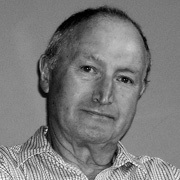
Tom Finlayson
After building his first photographic darkroom at age 13, Tom Finlayson began his long television career by an unusual route, after abandoning engineering studies to become an actor.
Wellington-born, with schooling shared between Nelson and Wellington, Finlayson later quit studies in engineering and science at Canterbury University, in order to follow a stronger interest: theatre. He won a supporting role in a play directed by novelist and theatre addict Ngaio Marsh, and "attended just about every rehearsal, just soaking up what she did and said". Finlayson began directing plays, but plans to study drama in England were abandoned after he successfully auditioned for a new satirical TV show in Auckland.
In the end, the comedy never went into production; instead he was invited to join the group of trainee reporters on 60s magazine show Town and Around. The show's magazine format allowed for its share of lighter moments: more than once Finlayson found himself alongside Barry Crump, acting out scenes based on Crump's novels. He also made a cameo appearance in 1967 teleplay Slipknot, a murder mystery set in the Auckland art world.
After three years with Town and Around, Finlayson had learnt enough about journalism to win a job on flagship Australian programme This Day Tonight, the country’s first nightly current affairs show. Finlayson found himself working as a reporter and regional producer during times “of extraordinary political turmoil” — including the sacking of Australian Prime Minister Gough Whitlam. He regards the period as the crucible where he was tempered as producer.
Ex-Town and Around producer Allan Martin had established This Day Tonight. In 1975 Martin returned to Auckland to helm the new second television channel. Finlayson followed, and became news editor of current affairs show News at Ten, which introduced the concept of twin newsreaders in Auckland (Tom Bradley) and Wellington (Philip Sherry). Despite winning the second channel one of its first Feltex awards in 1976 (for best current affairs programme) News at Ten was cancelled after only a year.
Finlayson would later become one of the second channel’s leading drama personnel. He began the move from current affairs into drama in 1978, by producing soap Radio Waves, which revolved around the staff at an Auckland radio station. Audience numbers for the series were hampered by South Pacific Television’s then limited reception. There may have also been a regional element to the show's appeal, as it rated at its lowest in Dunedin, and highest in Auckland.
In the 80s Finlayson was tasked with getting Maurice Gee’s science fiction tale Under the Mountain onto the screen, alongside impressively "calm and steady" director Chris Bailey. The classic tale of psychic children and slimy aliens presented many logistical challenges, not least keeping a handle on a group of aliens who were needed on set in various stages of transformation, all the way from "not quite right" humanoids to giant slugs.
In the same period he also co-created one of NZ’s most successful police shows, Mortimer’s Patch. Finlayson and fellow producer Kevan Moore had seen the ratings failure of recent Auckland-set soaps as a sign that local viewers preferred watching programmes set outside the city. Mortimer’s Patch centered around a city detective sergeant sent out to work in a small rural town. Finlayson was convinced that Terence Cooper was the man to play the main role. As Finlayson writes here, the show would win awards, high ratings, abrupt cancellation, then resurrection.
In 1982 Finlayson joined with events impressario turned TV producer Logan Brewer to form Finlayson Brewer Productions. Finlayson was also working with Brewer in a second company: Finlayson-Hill Productions debuted with 1984 Mortimer-movie spin-off Trespasses, which Finlayson produced with Dean Hill. Finlayson also worked on the script with novelist Maurice Gee, and executive produced the comic-strip inspired Terry and The Gunrunners.
The trio of producers collaborated again on cross-cultural romance Other Halves, based on the Sue McCauley novel. The film was partly British funded, as was Finlayson-produced TV movie The Grasscutter, a thriller about an Irishman emigre being pursued in the South Island by the fellow terrorists he betrayed. Mortimer’s Patch star Terence Cooper (born in Northern Ireland) played one of them.
Finlayson and his longtime partner Marcia Russell (who passed away in late 2012) were also proprietors of production company Images Ink, named after their respective strengths in images and writing. Under the Images Ink umbrella, Finlayson has directed documentaries on sailor Grant Dalton (Watch Me Next Time), the Seville Expo, and the intellectually-disabled. Outside of Images Ink, he also helmed a documentary on Dame Catherine Tizard’s rise to becoming Governor-General.
In 1993 Finlayson began a three-year stint as TVNZ Director of Production. His job was seeking out and commissioning programmes, whether shows made externally or in-house by TVNZ’s Māori, children’s and ‘lifestyle’ departments. Finlayson saw his task as endeavouring to defend the public broadcaster quotient, and balancing it with the burgeoning commercial demands of the time. In this period local programmes screening on TVNZ often filled half the positions in the top ten of highest rating shows screening across all networks.
At TVNZ Finlayson also worked with Creative NZ and NZ On Air on a documentary fellowship that allowed filmmakers to work on long-form docos (the fellowship funded Annie Goldson’s Seeing Red and Merata Mita’s Hotere). After leaving TVNZ, Finlayson continued to work on contract as executive producer on ambitious James Belich series The New Zealand Wars, and did 18 months as director of public programmes at Auckland War Memorial Museum.
In 2014 he completed a linguistics PhD at Auckland University, on changes in the language of political interviews.
Son Nic Finlayson began as a cameraman, and now directs commercials around the world.
Sources include
Tom Finlayson
Trisha Dunleavy, Ourselves in Primetime: A History of New Zealand Television Drama (Auckland University Press, 2005)